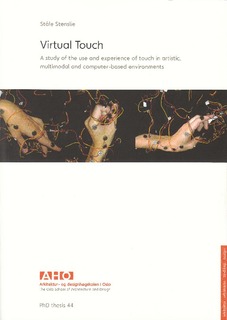Virtual touch : a study of the use and experience of touch in artistic, multimodal and computer-based environments
Doctoral thesis, Peer reviewed
Permanent lenke
http://hdl.handle.net/11250/93049Utgivelsesdato
2011Metadata
Vis full innførselSamlinger
- Design [33]
Originalversjon
Stenslie, Ståle. (2010). Virtual touch: a study of the use and experience of touch in artistic, multimodal and computer-based environments. [Oslo]: Arkitektur- og designhøgskolen i Oslo.Sammendrag
The central focus of this thesis is the use and experience of touch in artistic, multimodal and computer-based environments. The haptic experience of touch is an area that has only received limited research-based interest. Touch is too often seen as the effect, and not the cause of our everyday experiences. The study aims to provide an improved knowledge of how touch functions and how haptic storytelling can be used as an artistic medium. This thesis is divided into seven parts. The introductory chapter presents the structure of the study and the history leading up the formulation of research questions and hypotheses. Further it contextualizes the research in a broader context. The second chapter presents my bricolage of methodological choices and puts them in relation to art, technology and aesthetics. Here the
thesis is presented as practice-based research focused on my artistic experiment Erotogod. The third chapter investigates the foundations of touch through a physiological and psychological approach. Chapter four presents an alternative haptic history of Virtual Realities through the presentation and discussion of several technological and artistic works that are computerbased.
In chapter five touch is approached from a theoretical point of view. It develops a theory of touch based on phenomenology and shows how this approach advances an embodied thinking. Chapter six presents practice-based experiments of touch through the Erotogod installation. The last and seventh part is the analysis and conclusion of my experiments. The problems addressed concern how it feels to touch and be touched in multimodal environments, or so called Virtual Realities. Firstly how haptic, corporeal interaction influence the overall experience of a given interactive human-to-computer system. Secondly it addresses the role of vibrotactile stimulation within multimodal, computer-enabled environments. Another problem addressed is examining the way touch can be used to construct meaningful haptic content and experiences in the context of art. The method of solving the problems has been developed through practicebased research in the arts. The thesis examines and assesses the scope of the research appropriate to art practice. This is done primarily through the investigation and assessment of practical art experiments as a working method. Specifically the bodysuit of the practice-based experiment Erotogod functions as a two-way tactile display, conveying vibrotactile feedback to the body and interfacing the human to the computer through touch. Erotogod
portrays how touch appears in works of art, and how it affects the artworks. Theoretically touch is investigated through a phenomenological approach on the way the world of our experience is constituted for us. This experimental approach centres on the phenomenon of perceptional
breakdown and how this reveals dimensions of touch. A phenomenology of touch as it appears here, allows us to understand the interplay between subjective, felt embodiment and the psychophysically-contextualized work of art The main results and applications of the study are firstly that haptic technologies bridge the gap between the real (corporeal) and the virtual (immaterial) world, supporting the assumption that the distinction between the ‘virtual’ and the ‘real’ is not convincing in itself. Haptic stimuli in general and vibrotactile stimuli in particular, can have the effect of making the virtual appear more real. Another result is showing how haptic experiences add to the user’s qualitative experience of a multimodal art installation. Technologically the thesis shows how higher sensory resolution adds to the
sense of being immersed in a physically ‘real’ virtual world. Important for future studies is the way my research indicates new possibilities of haptic expressions that can form general expressions to be used in future forms of haptic storytelling. Further the thesis presents a long-term documentation and development of touch-based interactions. New in this thesis and approach are the combinations of various theories of touch, and in particular its application to works of art where touch appears as a genuine artistic medium. It also contributes to the definition of new practices of inquiry and knowledge-making. Conclusions: This thesis contributes substantially to knowledge generation about the multimodality of touch within the art field. I hope that it also opens
